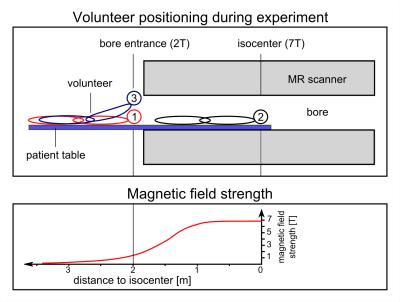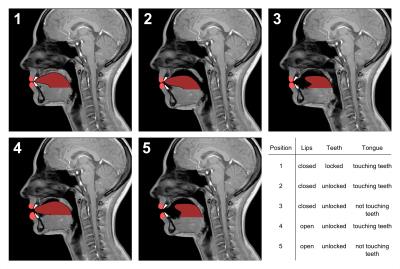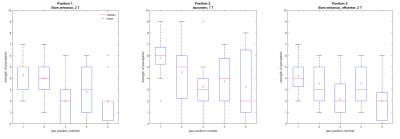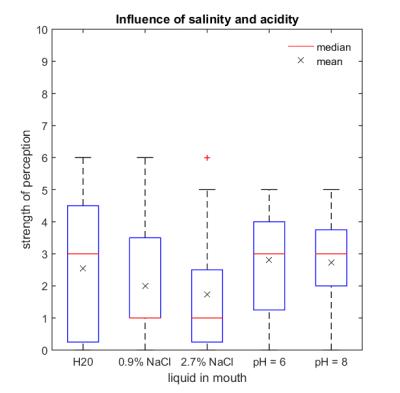2619
Metallic taste perception at 7 Tesla: Influences of jaw position and ionic composition of saliva1Computer Assisted Clinical Medicine, Medical Faculty Mannheim, Heidelberg University, Mannheim, Germany, 2Medical Physics in Radiology, German Cancer Research Center (DKFZ), Heidelberg, Germany, 3Institute of Radiology, University Hospital Erlangen, Erlagen, Germany
Synopsis
Up to 40% of subjects report metallic taste sensations when exposed to strong magnetic fields. Can the perception of metallic taste during an ultra-high field (UHF) examination be lessened and thus increase patient comfort? This study experimentally examines the influence of jaw position and ionic composition of saliva (salinity and acidity) on metallic taste perception. We found that simple changes in tongue and teeth positions as well as saline in the mouth decrease the metallic taste sensation during UHF exposure. Following the current trend to UHF applications, these findings allow for further insight regarding increased patient comfort and acceptance of UHF examinations.
Introduction
Up to 40$$$\,$$$% of workers, volunteers, and patients reported a temporary metallic taste sensation when exposed to ultra-high magnetic fields (UHF:$$$\,$$$B$$$\,$$$≥$$$\,$$$3T),1,2 especially while moving the head.1,3,4 Previous work proposed the induction of currents or direct nerve stimulation as possible mechanisms.1 We hypothesize a relation to ionic environment and mouth geometry, since both current flow and stimulation of the ion-channel taste receptors might influencethese factors. Past studies did neither describe exact anatomical jaw positions nor a potential influence of the ionic composition of saliva. Therefore, this study investigated in detail variation of taste perception related to anatomical jaw positions and composition of saliva in terms of salinity and acidity.Materials and Methods
Experiments were carried out in the stray field of a passively shielded 7T MRI scanner.5 Subjective taste perception was studied in 11 volunteers (6$$$\,$$$male, 5$$$\,$$$female, mean age 27$$$\,$$$years) for varied jaw positions (Part 1) and different ionic oral environments (Part 2). Before commencement, saliva pH value of each volunteer was recorded using pH test strips.6
Volunteers rotated their head from left to right with a frequency of 100$$$\,$$$bpm for 6$$$\,$$$seconds to induce taste sensation. Pacing was given by a metronome. Afterwards, volunteers scored their taste perception on a scale from 0 (no taste) to 10 (strong metallic taste perception). To increase inter-subject comparability, volunteers performed the motion prior to the experiment at location 3 (Fig.$$$\,$$$1) with jaw position 1 (Fig.$$$\,$$$2) and defined this specific taste sensation as a “5”. During all experiments, volunteers were positioned head-first supine comparable to standard patient positioning.
Part 1: To examine the influence of anatomical jaw positions on taste perception, five different positions (Fig.$$$\,$$$2) were tested in randomized order. The experiment was performed at three different locations (bore entrance, bore entrance off-center, isocenter (Fig.$$$\,$$$1)) to additionally test for field strength dependency.
Part 2: Furthermore, we investigated the potential influence of the ionic oral environment on metallic taste sensation. Three solutions with varied salinity (demineralized water, 0.90$$$\,$$$%$$$\,$$$NaCl and 2.7$$$\,$$$%$$$\,$$$NaCl), one acidic solution (pH$$$\,$$$=$$$\,$$$6) and one alkaline solution (pH$$$\,$$$=$$$\,$$$8) were prepared from commercially available table salt,7 citric acid,8 and baking soda.8 Volunteers were positioned at location 3 with jaw position 1 and handed 30$$$\,$$$ml of the respective solution to keep in their mouths during taste inducing motion. Between each test, the mouth was rinsed with demineralized water.
Results and Discussion
All volunteers experienced metallic taste during head rotation – even at low field strength at the bore entrance. Apparently, dental implants are not a prerequisite for the sensation. 6 volunteers had a dental retainer, 7 had dental fillings (none amalgam) and 3 no implants at all. Mean pH value before the experiment was 6.9. Overall results suggest that not only 40$$$\,$$$% of subjects experience the taste sensation as reported before, but everyone if the sensation is specifically provoked as in these experiments. Perceived taste intensity depended on jaw position and location (Fig.$$$\,$$$3). Strongest taste sensation (average 5.8$$$\pm$$$1.8) was found for position 1 (lips closed, tongue touching locked teeth) with head positioned at isocenter. Weakest taste sensation (1.9$$$\pm$$$2.0) was found for position 5 (lips closed, tongue not touching unlocked teeth) at the center of the bore entrance. A spatial B-field gradient (location 3) did not significantly change taste perception compared to location 1. The experiment on the effect of salinity and acidity showed generally lower taste intensity if a liquid was present in the mouth (Fig.$$$\pm$$$4). Demineralized water reduced the mean perception from 4.2$$$\pm$$$1.5 to 2.5$$$\pm$$$2.2. The sensation decreased with increasing salinity (2.0$$$\pm$$$2.0 for 0.9$$$\,$$$%$$$\,$$$NaCl, 1.7$$$\pm$$$2.1 for 2.7$$$\,$$$%$$$\,$$$NaCl). No additional dependency on pH values was found. Hence, an influence of the H+ or OH- ion abundance in saliva on metallic taste sensation appears unlikely.Conclusion
Our experiments demonstrate the possibility to influence the intensity of metallic taste perception while exposed to strong magnetic fields. The sensation is reduced when the tongue is not touching the teeth and if liquids, especially saline, are present in the mouth. Thus, the adverse side effect of metallic taste perception during exposure to magnetic fields may be lessened or in some cases even avoided by simple changes in mouth position or the intake of a salty aliment. Although metallic taste does not usually limit the acceptance of UHF examinations at 7T, the results of this work might become more relevant at extremely high magnetic field strengths such as 14T or 20T. The understanding of physiological mechanisms of metallic taste remains for future work. However, in consideration of the current trend to UHF applications, these findings add some understanding on ways to increase patient comfort and acceptance of UHF examinations.Acknowledgements
No acknowledgement found.References
[1] Cavin, ID, Glover, PM, Bowtell, RW, and Gowland PA. Thresholds for perceiving metallic taste at high magnetic field. Journal of Magnetic Resonance Imaging. 2007; 26: 1357–1361.
[2] Theysohn JM, Maderwald S, Kraff O, et al. Magnetic Resonance Materials in Physics. 2008; 21: 63-72.
[3] de Vocht F, van Drooge H, Engels H, and Kromhout H. Exposure, health complaints and cognitive performance among employees of an MRI scanners manufacturing department. Journal of Magnetic Resonance Imaging. 2006; 23: 197–204.
[4] Rauschenberg J, Nagel AM, Ladd SC, et al. Multicenter Study of Subjective Acceptance During Magnetic Resonance Imaging at 7 and 9.4 T. Investigative Radiology. 2014; 49, 249–259.
[5] Siemens, Erlangen, Germany.
[6] Macherey-Nagel, Düren, Germany.
[7] Südsalz GmbH, Bad Reichenhall, Germany.
[8] Dr. Oetker GmbH, Bielefeld, Germany.
[9] Field distribution adapted from measurements by J. Gröbner: Gröbner J., PhD Thesis, Heidelberg University, 2011.
[10] 7T MR compatibility data sheet, Siemens, Erlangen, Germany. p. 24: Whole-body magnet (PS).
Figures

Fig. 1: Schematic drawing of volunteer positioning in the scanner room (top) and magnetic field strength amplitude at these locations (bottom).9
Location 1: head-first supine with head placed centered at the bore entrance (field strength B ≈ 2 T, spatial gradient G ≈ 4 T/m).10
Location 2: head-first supine with the head at isocenter (B ≈ 7 T, G = 0 T/m).10
Location 3: head-first supine with the head placed off-centered at the bore entrance (B ≈ 2 T, G ≈ 4.5 T/m).10


